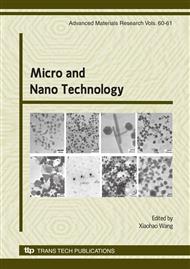p.347
p.353
p.357
p.361
p.367
p.371
p.375
p.380
p.388
Simulation of the Optical Properties for Silicon Nano-Pillar Array Using Finite Difference Time Domain Method
Abstract:
We use two-dimensional FDTD (Finite difference time domain) method to simulate light transmitting in Si nano-pillar arrays and get some results. The Si nano-pillar array, with diameters, heights, intervals respectively 50-80nm, less than 480nm, 26-44nm, is used as the testifying structure. The reflectivities of both experiment and simulation match well either for bulk silicon or for structure silicon even though small deviations are caused by the uneven size of the pillar’s diameters, heights, and intervals. What’s more, we find reflectivity (ref) increases along with diameter’s (d) increasing for a single pillar with diameters of 20-100nm under a constant light of 600nm, and reaches 10.48% at d=100nm. And with a constant d equal to 20nm, an infinite aspect ratio (r) and a light 600nm, ref is decreasing when the intervals (i) of pillars are increasing. Finally, under the condition of different i, the relations between ref and r are investigated. The undulation of these curves shows that the reflective waves play an important role in sub-wave length optics. Analysis also reveals that there exists a best i for achieving the lowest ref, too large or too small i will cause high ref, even if r is great; moreover, the lager i is, the higher pillar is needed to achieve the lowest ref.
Info:
Periodical:
Pages:
367-370
Citation:
Online since:
January 2009
Authors:
Keywords:
Price:
Сopyright:
© 2009 Trans Tech Publications Ltd. All Rights Reserved
Share:
Citation:


